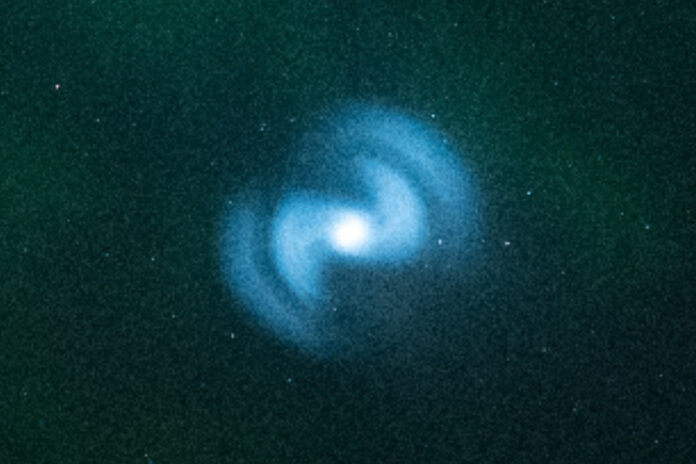A strange spiral in the night sky was caught on camera above Norway in northern Europe this week, mystifying onlookers.
One picture was snapped by an observer named Bettina Begtoft last week, just over the Barents Sea, with others spying the spiral from Iceland, where it could be seen alongside the northern lights. The helix has now been confirmed to have been caused by the launch of a SpaceX rocket from California’s Vandenberg Space Force Base on March 4.
Bettina Begtoft
“I noticed it at 2:02 a.m. local time,” Begtoft told spaceweather.com. “To the naked eye, it looked white, but my Nikon D750 camera revealed the beautiful blue color.”
Begtoft told Newsweek: “It was a fantastic phenomenon to watch in the sky. All the parameters were lined up that evening, and I just happened to have been in northern Lofoten, right under the trajectory of the SpaceX rocket, with totally clear skies, aurora… it was truly beautiful.
“It was the result of a great teamwork with my friend and astronomer Olivier Staiger, based in Switzerland, who informed me of the possible spiral. We stayed in close contact that evening to monitor all the data, timing, etc.,” Begtoft said.
These spirals are usually temporary and are not harmful; they are simply a result of the physics of rocket propulsion interacting with the surrounding atmosphere. This particular spiral was caused by the launch of a SpaceX Falcon 9 rocket, which was part of the Transporter-10 mission, carrying 53 small satellites into orbit. The rocket’s second stage was discarded as it passed over the Barents Sea, where it performed a de-orbit burn, using propellant to push itself back into the Earth’s atmosphere.
The second stage typically has its own rocket engine, which is optimized for operation in the vacuum of space, where atmospheric resistance is no longer a factor. This engine may use different propellants than the first-stage engine, often chosen for their efficiency in the vacuum environment.
As the second stage fell, it started to spin, resulting in its exhaust spiraling around it. This exhaust, mostly made of water and CO₂, forms a cloud in space that is lit up by the light of the sun, glowing in the dark skies.
“It looks to be simply the exhaust gas from the rocket engine being ionised by energetic electrons present in the ionosphere and thus emitting light; the color will be characteristic of the chemical elements in the propellants used,” Craig Underwood, an emeritus professor of spacecraft engineering at the University of Surrey in the U.K., told Newsweek. “The rocket stage is rotating, hence the spiral.”
This venting is also done to avoid any remaining fuel in the engine exploding as the second stage burns up in the atmosphere.
The spiral was so visible due to the sun’s increased activity at the moment.
“This causes high-energy electrons to spiral around the magnetic field lines of the Earth, converging at the two poles, where they meet the upper atmosphere. This happens all the time, but we only notice it when the sun is particularly active, and therefore the aurorae are particularly bright; they are usually too dim to see,” Underwood added.
“When these electrons encounter gas (such as the oxygen and nitrogen in the upper atmosphere), they ionize the gas and the consequent reactions emit a characteristic color of light (in the case of oxygen and nitrogen, mainly pinkish-red and green); the familiar aurorae. There are other colors present, too, including the whitish color seen in the spiral. If other gases are injected (such as the rocket exhaust gas from the SpaceX vehicle), these too will be ionized and glow,” Underwood said.
This strange phenomenon has been spotted many times in the past after SpaceX launches, including over New Zealand, Hawaii, and Africa.
Do you have a tip on a science story that Newsweek should be covering? Do you have a question about rocket launches? Let us know via [email protected].
Uncommon Knowledge
Newsweek is committed to challenging conventional wisdom and finding connections in the search for common ground.
Newsweek is committed to challenging conventional wisdom and finding connections in the search for common ground.


